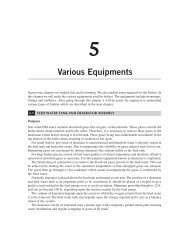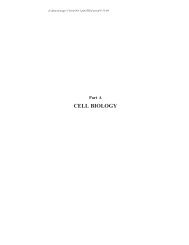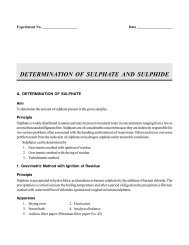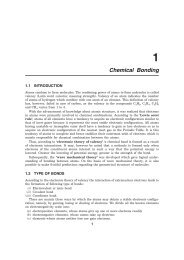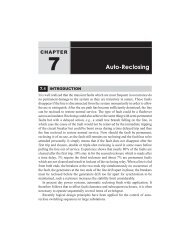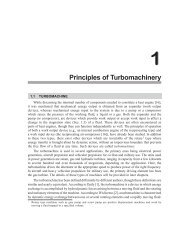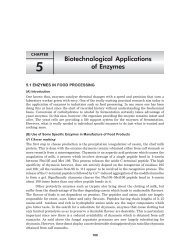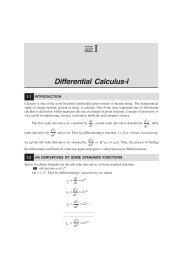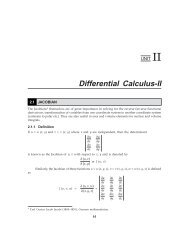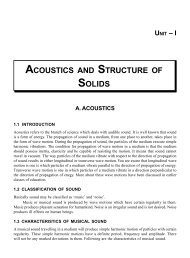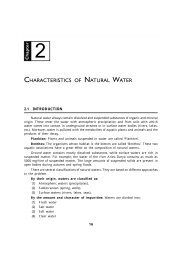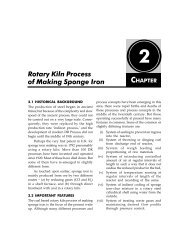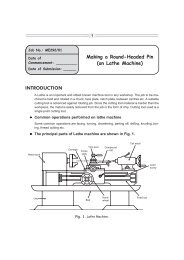1.1 introduction - New Age International
1.1 introduction - New Age International
1.1 introduction - New Age International
You also want an ePaper? Increase the reach of your titles
YUMPU automatically turns print PDFs into web optimized ePapers that Google loves.
1<br />
CHAPTER<br />
<strong>1.1</strong> INTRODUCTION<br />
ALGAE<br />
The word ‘algae’ is derived from a Latin word ‘alga’ which means ‘Sea weed’. Algae are chlorophyll<br />
bearing autotrophic thallophytes. Study of algae is called Phycology (Greek word ‘phycos’ means sea<br />
weed and ‘logos’ means study). This group is one of the largest of the Plant Kingdom.<br />
Algae are distributed in almost all the types of habitats. Plants are thalloid and show great variation<br />
in thallus organisation. They include motile unicellular forms, motile colonial forms, palmelloid,<br />
filamentous, heterotrichous, siphonaceous, uniaxial and multiaxial thalli.<br />
The cells constituting the thalli are basically of two kinds prokaryotic and eukaryotic The cells in<br />
all members of algae remains surrounded by a cellulose cell wall which encloses the protoplast. Members<br />
belonging to Cyanophyceae have a prokaryotic cellular organisation while all the other members show<br />
eukaryotic organisation.<br />
Plants reproduce by vegetative, asexual and sexual methods. In Cyanophyceae sexual reproduction<br />
is not known. Vegetative reproduction is by fragmentation, fission, akinetes, bulbils, amorphous bulbils,<br />
amylum stars, hormogones or by tubers. Asexual reproduction is by formation of zoospores, aplanospores,<br />
hypnospores and tetraspores. Sexual method of reproduction ranges from isogamy to oogamy.<br />
Algae have been variously classified by numerous phycologists. The most simple and practical<br />
classification was proposed by F.E. Fritsch (1935, 1945). Fritsch classified algae into 11 classes. They are<br />
1. Chlorophyceae<br />
2. Xanthophyceae<br />
3. Chrysophyceae<br />
4. Bacillariophyceae<br />
5. Cryptophyceae<br />
6. Dinophyceae<br />
7. Chloromonadinae<br />
8. Euglenineae<br />
9. Phaeophyceae<br />
10. Rhodophyceae<br />
11. Myxophyceae (Cyanophyceae)
2 Practical Manual for Botany, Vol.-I<br />
1.2 OSCILLATORIA<br />
Division — Cyanophyta<br />
Class — Cyanophyceae<br />
Order — Nostocales<br />
Family — Oscillatoriaceae<br />
Genus — Oscillatoria<br />
Identifying Characters<br />
1. Trichomes are without heterocysts and without branching (A single row of cells in a filamentous<br />
colony is known as trichome). The trichome along with sheath is called filament.<br />
2. Biconcave separating discs are present.<br />
3. Free surface of the terminal cell is thickened to form calyptra.<br />
Distinguishing Characters<br />
Apical cell<br />
Separation<br />
disc<br />
Hormogonium<br />
Fig. <strong>1.1</strong> Oscillatoria : Thallus structure<br />
1. Majority of the species inhabit fresh water while others are marine. They are commonly found<br />
as floating masses in rainwater, pools, puddles and also found on moist soils.<br />
2. They may occur singly or interwoven with each other forming extensive masses on terrestrial<br />
substrate.<br />
3. It is an unbranched filamentous alga.<br />
4. Each trichome is comprised of numerous cells, which are broader than long and are placed end<br />
to end in a row. They are unbranched, cylindrical, lacks a sheath or possess delicate inconspicuous<br />
sheath.<br />
5. All cells resemble each other except the terminal cell, which is colourless and variously shaped.<br />
This cell has thick outer covering called calyptra.
Algae 3<br />
6. Cells are prokaryotic. Each cell has peripheral coloured chromoplasm and central colourless<br />
centroplasm. Pigments and reserve food materials are found in chromoplasm. In centroplasm<br />
nuclear material is seen.<br />
7. In floating species pseudovacuoles (gas vacuole) are present in the chromoplasm.<br />
8. Trichome exhibit gliding, rotatory, oscillatory movements hence the name Oscillatoria.<br />
9. Reproduction is by fragmentation and hormogone formation.<br />
10. The broken filaments which consist of 2–3 cells are called hormogones.<br />
11. Hormogones are formed due to death of intercalary cells or by special separating biconcave cells<br />
or disc.<br />
1.3 NOSTOC<br />
Division — Cyanophyta<br />
Class — Cyanophyceae<br />
Order — Nostocales<br />
Family — Nostocaceae<br />
Genus — Nostoc<br />
Identifying Characters<br />
1. Trichomes unbranched, moniliform and contorted.<br />
2. Akinetes and intercalary heterocysts are present.<br />
3. Algae form jelly like balls in which numerous filaments are embedded.<br />
4. Cells are prokaryotic.<br />
a Nostoc ball<br />
Substratum<br />
A<br />
Mucilagenous<br />
Sheath<br />
B<br />
Intercalary heterocyst<br />
Akinetes<br />
Cyanophycin granule<br />
Fig. 1.2 Nostoc: A. Gelatinous colony, B. Trichome
4 Practical Manual for Botany, Vol.-I<br />
Distinguishing Characters<br />
1. They occur both in aquatic and terrestial habitats.<br />
2. Thallus is filamentous. Filaments do not occur singly but often grow as large colonies of closely<br />
packed trichomes, embedded in a firm matrix of gelatinous material.<br />
3. Each trichome is enclosed by its own mucilaginous sheath and is called a filament.<br />
4. Colonies are spherical in shape, solid or hollow. Surface may be smooth or verrucose.<br />
5. Trichomes are unbranched, contorted and moniliform.<br />
6. Cells of the trichome are spherical or oval and joined end to end resembling a string of beads.<br />
7. In between the vegetative cells there are specialized enlarged thick walled empty looking cells<br />
called heterocysts.<br />
8. Cells are prokaryotic. They have centrally located centroplasm and peripheral coloured<br />
chromoplasm having pigments and reserve food materials.<br />
9. Heterocysts are intercalary or terminal. They are spherical, enlarged, thick walled yellow coloured<br />
cells. Each heterocyst has two polar pores plugged by polar nodules, each one adjacent to the<br />
neighbouring cell. Terminal heterocysts have a single polar nodule. These help in nitrogen<br />
fixation and hormogone formation.<br />
10. Reproduction is by the formation of hormogones and akinetes. Sexual reproduction is absent.<br />
11. Akinetes are thick walled resting resistant spore like vegetative cells. These occur in chains<br />
next to heterocyst.<br />
1.4 SCYTONEMA<br />
Division — Cyanophyta<br />
Class — Cyanophyceae<br />
Order — Nostocales<br />
Family — Scytonemataceae<br />
Genus — Scytonema<br />
Heterocyst<br />
False branch<br />
Mycilagenous sheath<br />
Cells<br />
Nodule<br />
Fig. 1.3 Scytonema : Thallus structure
Algae 5<br />
Identifying Characters<br />
1. Trichomes show false branching.<br />
2. Trichomes have heterocysts.<br />
Distinguishing Characters<br />
1. Commonly occurs in sub-aerial habitats. Some are free floating in aquatic habitats.<br />
2. Filaments occur single and trichome remains enveloped in sheath.<br />
3. Filaments show false branching, which is single or geminate (in pairs).<br />
4. False branching occurs due to breakage of trichome within the sheath and one or both the<br />
broken ends of trichome protrudes out of the sheath and develop into branches.<br />
5. False branching occurs due to degeneration of one or more intercalary cells by the breakage of<br />
trichome near the intercalary heterocyst or by the formation of loops.<br />
6. Trichomes are of same diameter throughout with cylindrical cells. Cells are shorter than broad.<br />
7. Trichome is covered by an individual sheath, which is firm and hyaline or coloured.<br />
8. Heterocysts are intercalary and are of the same size as that of vegetative cells. Branching occurs<br />
at the region of hererocyst.<br />
9. Heterocysts are thick walled specialized vegetative cells, help in nitrogen fixation.<br />
10. Cells are prokaryotic with outer coloured chromoplasm and inner colourless centroplasm.<br />
11. Sexual reproduction is absent.<br />
12. Hormogone formation is common mode of multiplication. They are formed at the ends of<br />
trichome.<br />
1.5 VOLVOX—COLONY<br />
Division — Chlorophyta<br />
Class — Chlorophyceae<br />
Order — Volvocales<br />
Family — Volvocaceae<br />
Genus — Volvox<br />
Identifying Characters<br />
1. Thallus is a coenobium.<br />
2. Coenobia are spherical or oval.<br />
3. Chloroplast of individual cell is cup shaped.<br />
Distinguishing Characters<br />
1. It occurs as minute green balls of small pinhead size, in temporary and permanent fresh water<br />
pools and ponds.
6 Practical Manual for Botany, Vol.-I<br />
Cytoplasmic strands<br />
Gelatinous sheath<br />
Fig. 1.4 Volvox sp. (A, vegetative ; B, portion in detail)<br />
A<br />
B<br />
2. Thallus is a motile coenobium.<br />
3. Colonies are mostly spherical, round or oval in shape.<br />
4. Colony is a hollow sphere and the motile cells are arranged in a single layer towards the periphery.<br />
5. Layer of cells are surrounded by gelatinous mass forms the outer firm limiting layer.<br />
6. The number of cells in a colony varies from 500 – 60,000 according to species.
Algae 7<br />
7. Each cell in the colony is connected with a few of the neighbouring cells by thin and delicate<br />
cytoplasmic strands.<br />
8. Each cell is surrounded by its own gelatinous sheath.<br />
9. All the cells in the colony are Chlamydomonas like.<br />
10. Each cell is biflagellate motile and ovoid. Flagella are whiplash type and anteriorly inserted.<br />
Two contractile vacuoles are situated at the base of flagella. Cytoplasm has cup shaped chloroplast<br />
with a pyrenoid, an eye spot and a single nucleus. Cytoplasm is rich in volutin granules.<br />
11. It moves through water rotating slowly with one end of the sphere always leading – hence<br />
rolling alga.<br />
12. Cells in the colony show division of labour – only few cells take part in reproduction.<br />
13. Asexual reproduction is by formation of daughter colonies.<br />
14. Sexual reproduction is Oogamous.<br />
15. Colonies may be monoecious or dioecious.<br />
16. Male reproductive organs are antheridia, which develop at the posterior part of the colony.<br />
17. Each antheridium produces 128 or 512 biflagellate sperms, which are liberated as bowl shaped<br />
plate or hollow sphere.<br />
18. Female sex organ is oogonium formed at the posterior end. It produces a single egg which is<br />
non-motile.<br />
19. Zygote produced as a result of fertilization is thick walled and orange red in colour. The outer<br />
layer is often ornamented.<br />
VOLVOX—Asexual Reproduction by Daughter Colonies<br />
1. Asexual reproduction in Volvox is by means of daughter colonies.<br />
2. Volvox is a motile colonial coenobium, found in fresh waters.<br />
3. The individual cells are Chlamydomonas like and arranged at the periphery of the coenobium.<br />
4. Asexual reproduction takes place by formation of daughter colonies.<br />
5. About 2 – 50 cells in the posterior half of the colony enlarge in size and are called gonidial cells,<br />
which by repeated longitudinal divisions give rise to daughter colonies.<br />
6. The eight cells are formed by the longitudinal division of the gonidial cells are arranged in a<br />
curved plate and is called plakea stage, which by further longitudinal divisions produce several<br />
cells arranged in a hollow sphere with a small aperture called phialopore.<br />
7. All the cells are naked and without flagella with anterior end pointed towards the center.<br />
8. Normal orientation is attained by complete inversion of the young coenobium through<br />
phialopore.<br />
9. Naked protoplasts secrete cell wall and develop flagella at their anterior ends and develop into<br />
daughter colony.<br />
10. The young colonies escape by the disintegration of the parent colony or through a pore at the<br />
position of the original gonidium.
8 Practical Manual for Botany, Vol.-I<br />
Fig. 1.5 Volvox sp. parent colony with a number of daughter colonies<br />
VOLVOX—Male Colony Showing Antheridia<br />
Daughter colonies<br />
1. Sexual reproduction in Volvox is oogamous.<br />
2. Antheridia are male reproductive organs.<br />
3. Sex organs may be monoecious or dioecious.<br />
4. Certain cells in the posterior region of the colony enlarge, retract their flagella and form<br />
gametangia.<br />
5. The male gametangia are called the antheridia.<br />
6. The protoplast of the antheridium divides longitudinally several times and produces 64 – 128<br />
cells, which after inversion are grouped as bowl shaped plate.<br />
7. In some species the divisions continue and produce 512 cells arranged in the form of the hollow<br />
sphere. Each cell develops into a spermatozoid or sperm.
Algae 9<br />
8. Each sperm is biflagellate conical or fusiform structure.<br />
9. The entire mass of biflagellate sperms are liberated as a single unit, which swims freely until it<br />
reaches the female colony.<br />
A<br />
Fig. 1.6 Volvox colony showing Artheridum A. Antheridium B-C development of sperms<br />
D-E antherozoids before and after inversion<br />
VOLVOX—Showing Oogonia—Female Colony<br />
1. Oogonia are female reproductive structures.<br />
2. Volvox is a motile coenobial form. It reproduces sexually by oogamous method.<br />
3. Sex organs may be monoecious or dioecious.<br />
4. Few cells at the posterior region enlarge, become rounded or flask shaped, retract their flagella<br />
and develop into oogonia.<br />
5. The entire protoplast of the oogonium gets metamorphosed into a single egg or oosphere.<br />
6. The egg has a large central nucleus and a parietal chloroplast having a large central nucleus and<br />
numerous pyrenoids and also stored with reserve substances.<br />
7. The oosphere develops a beak like protrusion, which marks the point of entrance of sperm.<br />
Somatic<br />
cell<br />
Immature<br />
egg<br />
B<br />
C<br />
Oogonium Mature<br />
egg<br />
Fig. 1.7 Volvox colony showing oogonium and oospore<br />
D<br />
Sperm<br />
E<br />
Oospore
10 Practical Manual for Botany, Vol.-I<br />
VOLVOX—Zygote<br />
1. In Volvox sexual reproduction is oogamous, and colonies may be monoecious or dioecious.<br />
2. Antheridia and oogonia are developed mostly in the posterior part of the colony.<br />
3. Antheridium produces biflagellate antherozoids and oogonium produces a single egg.<br />
4. Antherozoids fertilize the egg and an oospore or zygote is formed.<br />
5. The zygote is surrounded by a thick wall which is three layered and outer wall layer is smooth or<br />
spiny.<br />
6. The thick walled zygote remains in the parent coenobium for some time and develop sufficient<br />
haematochrome or red pigment to colour their protoplast orange red.<br />
1.6 OEDOGONIUM<br />
Vegetative Filament<br />
Division — Chlorophyta<br />
Class — Chlorophyceae<br />
Order — Oedogoniales<br />
Family — Oedogoniaceae<br />
Genus — Oedogonium<br />
Identifying Characters<br />
Fagellum<br />
Oogonium<br />
Single cell<br />
Fig. 1.8 Volvox. A colony with a zygote<br />
1. Thallus multicellular, filamentous and unbranched.<br />
2. Presence of cap cells.<br />
Parent colony<br />
Zygote
Algae 11<br />
Antheridia<br />
Nucleus<br />
Vegetative<br />
cell<br />
Oogonium<br />
Egg<br />
Suffultor cell<br />
Apical caps<br />
Reticulate<br />
chloroplast<br />
Cell wall<br />
Pyrenoid<br />
Cap cell<br />
Basal<br />
holdfast<br />
Nucleus<br />
Flattened<br />
disc<br />
Fig. 1.9 Oedogonium. A monoecious filament Fig. <strong>1.1</strong>0 Oedogonium cell<br />
Apical cap<br />
Pyrenoid<br />
Chloroplast<br />
Cell wall
12 Practical Manual for Botany, Vol.-I<br />
3. Oogonia spherical, larger than the vegetative cell and bears one or more apical rings.<br />
4. Chloroplast is reticulate with pyrenoids at the intersections.<br />
OEDOGONIUM–Vegetative Structure<br />
1. It is a common submerged aquatic alga often found attached to a solid object. Mature filaments<br />
are free floating.<br />
2. Thallus is filamentous, multi-cellular and unbranched.<br />
3. Filaments are uniseriate.<br />
4. According to position the filaments have three types of cells, (i) Basal (ii) Intercalary<br />
(iii) Apical.<br />
5. The basal cell of the filament functions as a hold fast. The lower part of the hold fast is either<br />
disc shaped or finger like. Upper part is broad and rounded and lacks pigments.<br />
6. The terminal or apical cell is broadly rounded.<br />
7. The intercalary cells are cylindrical longer than broad and the cell wall is made up of three<br />
layers inner cellulose, middle pectin and outer chitin.<br />
8. Internal to cell wall the cells have reticulate chlorplasts with numerous pyrenoids at the inter<br />
sections.<br />
9. Cells are uninucleate. Thin delicate cytoplasmic strands suspend nucleus.<br />
10. Some of the cells at their upper end possess small ring like markings called apical rings. These<br />
cells are called cap cells. Presence of apical rings indicates that the cells have undergone division.<br />
The annular splitting of the lateral cell walls forms apical rings. Number of rings indicates<br />
number of times the cell has divided.<br />
11. Asexual reproduction is by means of multiflagellate zoospores, which are produced singly in<br />
zoosporangia.<br />
12. Sexual reproduction is oogamous. Female sex organ is oogonium and male sex organs are<br />
antheridia. Each antheridium produces two multi-flagellate sperms.<br />
On the basis of distribution of antheridia two species of Oedogonium are identified.<br />
(1) Macrandrous and (2) Nannandrous.<br />
14. In Macrandrous species, the antheridia are found on the filaments of normal size.<br />
15. In Nannandrous species, antheridia are produced on much reduced male filaments called dwarf<br />
males.<br />
OEDOGONIUM—Cap Cells<br />
1. Oedogonium is a fresh water alga found in pools, lakes, tanks, etc.<br />
2. The thallus is multicellular, filamentous and unbranched.<br />
3. The basal cells of the filament function as hold fast.<br />
4. The cell at the tip of the filament is the apical cell.
Algae 13<br />
5. The intercalary cells are cylindrical with thick walls composed of 3 layers.<br />
6. Certain cells in every filament possess one or more ring like markings known as apical caps at<br />
their distal ends and these cells are known as cap cells characteristic feature of the Oedogonium<br />
species.<br />
7. The caps are formed as a result of the cell division. The number of caps in a cell indicates the<br />
number of times a cell has divided. When a cell divides a thickening is laid down in its upper<br />
end in the form of a ring on the inner side of the cell. The latter now stretches to form a new<br />
cell. Simultaneously the nucleus of the cell moves upward, divides mitotically into two and one<br />
of them passes into the newly formed cell, while the other remains in the parent cell. The new<br />
cell therefore has the wall chiefly formed by the stretching of the thickened wall material while<br />
the cap in fact is a small portion of the old cell wall.<br />
OODOGONIUM—Vegetative with Hold Fast<br />
1. Oedogonium is a fresh water green alga found in pools, lakes, tanks, etc.<br />
2. The thallus is multicellular, filamentous and unbranched.<br />
3. The basal cells of the filament function as a hold fast.<br />
4. The hold fast is generally colourless but may contain well-developed chloroplast and produce<br />
certain out growths, which help in attachment of the filament to the substratum.<br />
5. The cell at the tip of the filament is apical cell. The intercalary cells are cylindrical with thick<br />
wall composed of three layers.<br />
6. Certain cells in every filament possess one or more ring like markings known as apical caps at<br />
their distal ends and these cells are known as cap cells characteristic of Oedogonium species.<br />
7. Reticulate chloroplast lies internal to cell wall with many pyrenoids.<br />
8. The cells are uninucleate. Cytoplasmic strands suspend the single nucleus.<br />
OEDOGONIUM—Macrandrous Male<br />
1. In Macrandrous species, antheridia are produced on the filaments of normal size.<br />
2. The sexual reproduction in Oedogonium is oogamous and reproductive structures are oogonia<br />
and antheridia.<br />
3. In some species the antheridia and oogonia are produced on two different filaments. Such<br />
species are heterothallic and are called dioecious species.<br />
4. The filaments bearing antheridia are called macrandrous male. Macrandrous means the male<br />
and female filaments are of the same size.<br />
5. The antheridia are intercalary as well as terminal. They are formed from the antheridial mother<br />
cells. Each antheridial mother cell divides into two, the upper antheridial cell and lower sister<br />
cell. The antheridial cell is smaller. This cell may divide and redivide forming a chain of<br />
antheridia.<br />
6. The antheridia are flat, short, cylindrical or disc like cells of the filament.<br />
7. They lie in a row and their number varies from 2 to 40.
14 Practical Manual for Botany, Vol.-I<br />
8. The contents of each antheridium develop into two sperms, rarely into one.<br />
9. The sperms are liberated from the antheridia and each antherozoid is a pyriform structure with<br />
a colourless beak and a sub-apical crown of flagella (Stephanokont).<br />
a<br />
o<br />
A B C<br />
Fig. <strong>1.1</strong>1 Oedogonium. Distribution of sex organs in<br />
macrandrous sp. A, Macrandrous monoecious with<br />
the antheridia (a) and oogonia (o) on the same filament;<br />
B-C, Macrandrous dioecious with antheredia (a) on<br />
filament B and oogonia on filament C<br />
OEDOGONIUM—Macrandrous Female<br />
a<br />
o<br />
Fig. <strong>1.1</strong>2 Oedogonium. Oogonium with two dwarf<br />
males attached to it (Nannandrous species)<br />
1. The sexual reproduction in Oedogonium is oogamous and reproductive structures are oogonia<br />
and antheridia.<br />
2. In Macrandrous species, the antheridia are produced on the filaments of normal size.<br />
3. In some species, antheridia and oogonia are produced on two different filaments, such species<br />
are heterothallic and are called dioecious.<br />
4. The filaments bearing oogonia are called macrandrous female. Macrandrous means the male<br />
and female are of same size.<br />
5. Oogonia occur in intercalary or terminal position. Oogonia may be solitary or in a row of<br />
2–3.<br />
Caps<br />
Antheridia<br />
Stalk<br />
cell<br />
Oogonial wall<br />
Oogonium<br />
Cytoplasm<br />
Nucleus<br />
Pyrenoid<br />
Chloroplast<br />
Supporting cell
Algae 15<br />
6. Any vegetative cell of a filament can give rise to oogonia. The cell which gives rise to oogonia<br />
is called oogonial mother cell. It divides transversely into two. The upper cell enlarges into a<br />
flask shaped spherical oogonium. The lower cell is known as supporting cell or suffultory cell.<br />
In some the supporting cell divides subsequently and form a chain of oogonia.<br />
7. Oogonium encloses a single large ovum. The wall of the oogonium has a small pore on one side<br />
known as receptive pore just behind the receptive spot, which is a hyaline area in the protoplast<br />
of oogonium.<br />
8. Oogonium is uninucleate and protoplast is rich in reserve food.<br />
OEDOGONIUM—Nannandrous Male (Dwarf Male)<br />
1. In Nannandrous forms male filament is smaller in size and is known as a dwarf-male. The dwarfs<br />
are produced by the germination of androspore produced within androsporangia.<br />
2. If the androsporangia and oogonia are developed on the same filament such filaments are<br />
known as gynandrosporous.<br />
3. If they are borne on two different filaments they are called idioandrosporous species<br />
4. The contents of each androsporangium metamorphose into a single androspore, which is similar<br />
in structure to antherozoid but its size is intermediate between zoospore and antherozoid.<br />
5. After a short period it rests on oogonium or its stalk and germinate to give rise to dwarf male.<br />
6. Each dwarf male has a basal attaching cell and few antheridia. Each antheridium gives rise to<br />
two antherozoids.<br />
1.7 CHARA<br />
Division — Chlorophyta<br />
Class — Chlorophyceae<br />
Order — Charales<br />
Family — Characeae<br />
Genus — Chara<br />
Identifying Characters<br />
1. The thallus is macroscopic, branched and multicellular. The main axis is differentiated into<br />
nodes and internodes.<br />
2. At the node are present lateral branches of unlimited growth and branches of limited growth.<br />
3. Both the sex organs, the male sex organ is called ‘globule’ and female organ “nucule” are present<br />
at one point on the node of the short lateral branch.<br />
CHARA—Vegetative<br />
1. The plant body is calcified and commonly called “stone worts”.<br />
2. Chara is widely distributed in submerged conditions in fresh water pools, lakes and slow flowing<br />
streams.
16 Practical Manual for Botany, Vol.-I<br />
3. It is attached to muddy or sandy bottom of the pond or pool by means of rhizoids.<br />
4. The main axis consists of a series of alternating nodes and internodes.<br />
5. The internodes consist of a single undivided, elongated cylindrical cell.<br />
6. The node is made up of a transverse layer of short cells.<br />
7. From the nodes of the central axis arise whorls of primary laterals of limited growth and from<br />
the axils of primary laterals branches of unlimited growth arises. The primary laterals are also<br />
divided into a few nodes and internodes. From these nodes arise the secondary laterals.<br />
8. The internodal cells in the corticated species are surrounded by a number of sheath cells arising<br />
from the nodes above and below.<br />
9. The growth takes place by a single dome apical cell.<br />
Whorl of primary<br />
laterals<br />
Axillary branch<br />
Node<br />
Node<br />
Main axis<br />
Ascending<br />
cortical cell<br />
Secondary lateral<br />
Descending cortical<br />
thread<br />
Antheridium<br />
Oogonium<br />
Node<br />
Internode<br />
Node<br />
Fig. <strong>1.1</strong>3 Chara. Habit showing organisation of thallus Fig. <strong>1.1</strong>4 Chara. A fertile primary lateral
Algae 17<br />
CHARA—Sex Organs<br />
1. Sexual reproduction in Chara is oogamous.<br />
2. The sex organs are large, highly specialized and complicated in structure.<br />
3. The male sex organ is a large, round bright yellow or red structure; it is globule (antheridium).<br />
4. The female sex organ or the oogonium is a large, oval body covered with a multicellular envelope,<br />
it is known as nucule.<br />
5. The antheridium has a wall composed of eight closely fitting large hollow curved plate like cells,<br />
the shield cells. A rod shaped cell manubrium arises from the center of the shield cell, which<br />
bears primary and secondary capitula. The secondary capitula bear branched thread like cells,<br />
the spermatogenous filaments. Small discoid cells from spermatozoid mother filaments, spirally<br />
coiled, are given off by the spermatogenous filaments. Each spermatozoid mother cell develops<br />
into a band shaped spermatozoid.<br />
6. Nucleus is oval in shape and is situated above the globule at the node. It is enveloped by spirally<br />
coiled tube cells. At the apex of the nucule is a corona. Oosphere is single where a nucleus lies<br />
surrounded by the cytoplasm.<br />
1.8 VAUCHERIA—VEGETATIVE<br />
Division — Xanthophyta<br />
Class — Xanthophyceae<br />
Order — Heterosiphonales<br />
Family — Vaucheriaceae<br />
Genus — Vaucheria<br />
Oogonium<br />
Internode<br />
of primary<br />
lateral<br />
Corona<br />
Secondary<br />
lateral<br />
Antheridium<br />
Fig. <strong>1.1</strong>5 Chara. Sex organs
18 Practical Manual for Botany, Vol.-I<br />
Identifying Characters<br />
1. Thallus is tubular, cylindrical, branched, aseptate and coenocytic.<br />
2. Sex organs are antheridia and oogonia.<br />
Distinguishing Characters<br />
1. Species of Vaucheria are found in both fresh and seawater.<br />
2. Some species are terrestrial. In winter months, they occur as green matty structures on damp<br />
soils.<br />
3. The plant body is cylindrical, aseptate, monosiphonous and branched. Branching is monopodial.<br />
However, septa are formed at the base of the reproductive organs.<br />
4. Thallus is usually attached to the substratum by a colourless branched hold fast.<br />
Ovum<br />
Nuclei<br />
Germinated<br />
zoospor<br />
Central<br />
vacuole<br />
Oogonium<br />
Beak<br />
Antheridium<br />
Chloroplasts<br />
Cytoplasm<br />
Rhizoids<br />
Fig. <strong>1.1</strong>6 Vaucheria sp. Filament with rhizoids
Algae 19<br />
5. The plant body is multinucleate and acellular i.e., coenocytic and aseptate.<br />
6. Cell wall is thin elastic and consists of an outer layer of pectin and an inner layer of cellulose.<br />
7. There is a thin layer of cytoplasm, which encloses a large central vacuole that extends the entire<br />
length of the thallus.<br />
8. Within the cytoplasm there are many chromatophores and nuclei.<br />
9. Chromatophores are small ovoid or discoid and are arranged in the peripheral layer of cytoplasm.<br />
They have chlorophyll a, chlorophyll e, carotenoids and lack pyrenoids.<br />
10. Nuclei are found internal to chromatophores.<br />
11. Large number of oil droplets are found which make the reserve food material of the thallus.<br />
12. Reproduces asexually by multi-flagellate zoospores aplanospores and akinetes.<br />
13. Sexual reproduction is oogamous. Sex organs are antheridia and oogonia.<br />
1.9 ECTOCARPUS<br />
Division — Phaeophyta<br />
Class — Phaeophyceae<br />
Sub-class — Isogeneratae<br />
Order — Ectocarpales<br />
Family — Ectocarpaceae<br />
Genus — Ectocarpus<br />
Identifying Characters<br />
1. Thallus is branched, filamentous and heterotrichous.<br />
2. Thallus bears unilocular and plurilocular sporangia.<br />
ECTOCARPUS — Vegetative Structure<br />
1. It is a marine brown alga found in cold seas of temperate and Polar Regions.<br />
2. The thallus is filamentous, branched and heterotrichous showing the basal prostrate rhizoidal<br />
system and the aerial erect projecting photosynthetic system.<br />
3. The prostrate system is irregularly and frequently branched. It is separate and attaches the<br />
thallus to the substratum, thus serves as holdfast.<br />
4. Erect system arises from prostrate system and consists of many branched filaments, which are<br />
uniseriate i.e., single row of cells.<br />
5. Branching is lateral and each branch tapers into a series of elongated cells forming a colourless<br />
hair like structure.<br />
6. Cells are short and cylindrical. The cell wall is thick and consists of an outer layer of pectose<br />
and an inner layer of cellulose.<br />
7. The cells are uninucleate. Chromatophores are golden coloured and are either disc shaped or<br />
band shaped. They contain chlorophyll a and b and the characteristic xanthophyll, fucoxanthin.
20 Practical Manual for Botany, Vol.-I<br />
A. Showing habit B. Heterotrichous filament<br />
zoo-meiospore<br />
Plurilocular<br />
Sporangium<br />
Projecting system<br />
Prostrate system<br />
Unilocular Sporangium<br />
Chromatophore<br />
Nucleus<br />
Cell wall<br />
Fig. <strong>1.1</strong>7 Ectocarpus. Erect filament showing unilocular and plurilocular sporangia
Algae 21<br />
8. Growth in the rhizodial protions is apical and upright portion is intercalary.<br />
9. Genetically the thalli are of two kinds, haploid and diploid. Morphologically they are alike and<br />
alternate with each other in the life cycle.<br />
10. The diploid thallus bears two kinds of sporangia, unilocular and plurilocular.<br />
11. Unilocular sporangia after meiosis produces 32–64 haploid meiozoospores, which, give rise to<br />
haploid plants.<br />
12. Plurilocular sporangia are elongated, cone like, and contain many cubical cells each of which<br />
produces diploid zoospores.<br />
13. Haploid thalli produce biflagellate gametes in gametangia.<br />
14. Ectocarpus shows isomorphic alternation of generation.<br />
ECTOCARPUS—Plurilocular Sporangium<br />
1. The given slide is the plurilocular sporangia of Ectocarpus.<br />
2. The thallus of Ectocarpus is branched filamentous and heterotrichous.<br />
3. Genetically these are two types of thalli, i.e., haploid and diploid.<br />
4. Diploid thallus bears plurilocular sporangia, which are concerned with asexual reproduction.<br />
5. Plurilocular sporangia are found at the end of small branchlets.<br />
6. The terminal cell of the branchlet functions as the sporangial mother cell.<br />
7. Sporangia are elongated cone like structures and are made up of many small cubical cells arranged<br />
in 20–40 vertical rows.<br />
8. The cells of the sporangium are diploid and each of which produces a diploid zoospore, which<br />
on germination gives rise to diploid plant.<br />
9. The zoospores are pear shaped and have two laterally placed flagella, one is pantonematic and<br />
the other acronematic.<br />
ECTOCARPUS—Unilocular Sporangium<br />
1. The given slide is the unilocular sporangia of Ectocarpus.<br />
2. The thallus of Ectocarpus is branched filamentous and heterotrichous.<br />
3. Genetically there are two types of thalli, i.e., haploid and diploid.<br />
4. The diploid thallus bears unilocular sporangia.<br />
5. These are borne singly on lateral branches.<br />
6. Each sporangium is stalked globular or pear shaped structure having dense cytoplasm with<br />
many chromatophores and diploid nucleus.<br />
7. The diploid nucleus divides meiotically into 32–64 haploid nuclei. Each uninucleate protoplast<br />
develops into a haploid meiozoospore.<br />
8. Each meiozoospore is uninucleate, small pear shaped haploid structure with two laterally placed<br />
flagella, one is pantonematic and the other acronematic.<br />
9. The meiozoospores germinate and develop into haploid sexual plants.
22 Practical Manual for Botany, Vol.-I<br />
Fig. <strong>1.1</strong>8 Polysiphonia sp. showing habit<br />
Erect System<br />
Rhizoid<br />
Rhizoid<br />
Attaching<br />
disc<br />
Prostrate<br />
system<br />
Fig. <strong>1.1</strong>9 Polysiphonia. Thallus showing<br />
erect and prostrate filament<br />
Clysiphonous<br />
branch<br />
Apical cell<br />
Segment<br />
Central<br />
siphon<br />
Branch<br />
Initial Apical cell<br />
Young long<br />
branch<br />
Pit<br />
connection<br />
Central<br />
Siphon<br />
Fig. 1.20 Polysiphonia. A portion of thallus<br />
enlarged showing polysiphonous condition
Algae 23<br />
<strong>1.1</strong>0 POLYSIPHONIA<br />
Division — Rhodophyta<br />
Class — Rhodophyceae<br />
Sub-class — Florideae<br />
Order — Ceramiales<br />
Family - Rhodomelaceae<br />
Genus - Polysiphonia<br />
Identifying Characters<br />
1. The thallus is heterotrichus, filamentous and polysiphonous.<br />
2. Sexual reproduction is Ooganeous. Male sex organ is called spermatangium and female sex<br />
organ is called carpogonium.<br />
3. Haploid tetraspores are produced on tetrasporophyte.<br />
POLYSIPHONIA—Vegetative Structure<br />
1. It is a marine red alga and occurs in sublittoral zones of brackish estuaries and tidal pools.<br />
2. Thallus is brownish red to dark purple red in colour.<br />
3. Thallus is filamentous branched and heterotrichous.<br />
4. The prostrate portion of the thallus creeps on the substratum and is anchored to the substratum<br />
by thick walled unicellular rhizoids, the tips of which are flattened and disc like.<br />
5. The upright filaments are repeatedly branched and have delicate feathery appearance.<br />
6. Upright system has a main axis having long branches and short branches or trichoblasts.<br />
7. The main filament and long branches are polysiphonous, i.e., they consists of a system of<br />
parallel filaments called siphons, made up of elongated cells arranged one upon the other and<br />
connected by pit connections.<br />
8. There is one axial siphon called central siphon, surround by 4–20 pericentral siphons.<br />
9. The short branches (trichoblasts) are monosiphonous and dichotomously branched and bear<br />
sex organs.<br />
10. Each cell is uninucleate with many discoid chromatophores arranged in the periphery of the<br />
cytoplasm. Cells are connected with each other by cytoplasmic pit connections.<br />
11. Polysiphonia shows diplobiontic life cycle and is triphasic. It shows two diploid and one haploid<br />
individual. The individuals are:<br />
(a) Gametophyte—Free living haploid male and female plants having haploid sex organs<br />
spermatangia and carpogonia.<br />
(b) Carposporophyte—Diploid and dependent on gametophyte and produces diploid<br />
carpospores.<br />
(c) Tetrasporophyte—Diploid free living and produces haploid tetraspores.
24 Practical Manual for Botany, Vol.-I<br />
POLYSIPHONIA—Spermatangia<br />
1. The given slide shows the spermatangia, which are the male sex organs of Polysiphonia.<br />
2. The thallus of Polysiphonia is heterotrichous, filamentous, polysiphonous and branched.<br />
3. Male thallus bears spermatangia, which are closely packed and form a compact cone shaped<br />
structure on the short monosiphonous branches called male trichoblasts.<br />
4. The male trichoblast consists of two basal cells constituting the stalk, which forks into two<br />
branches of which one is fertile and the other is sterile.<br />
5. Spermatangia are spherical or oblong unicellular structures.<br />
6. It has a large nucleus and colourless cytoplasm.<br />
7. The spermatangial wall is thick and differentiated into 3 layers.<br />
8. The uninucleate protoplasm of spermatangium produces a single male gamete called spermatium.<br />
9. Spermatium is unicellular, spherical,non-motile structure and are liberated through a slit in<br />
the spermatangial wall.<br />
POLYSIPHONIA—Tetrasporangia<br />
Fig. 1.21 Spermatangium<br />
Fertile branch<br />
Pericentral cell<br />
1. The given slide is Polysiphonia showing tetrasporangia.<br />
2. The thallus of Polysiphonia is heterotrichous, filamentous, polysiphonous and branched.<br />
3. It shows diplobiontic life cycle and is triphasic, i.e., three individuals in the life cycle.
Algae 25<br />
4. Tetrasprophyte is the third individual in the life cycle. It is diploid and free living and bears<br />
tetrasporangia.<br />
5. Tetrasporangia are found in longitudinal series and develop from the pericentral cells.<br />
6. Tetrasporangia are small spherical bodies borne on short one celled stalk and are externally<br />
covered by two cover cells.<br />
7. Each tetrasporangium possesses four tetrahedrally arranged uninucleate haploid tetraspores.<br />
8. The tetraspores germinate to give rise to gametophyte.<br />
POLYSIPHONIA—Cystocarp<br />
Tetraspore<br />
Trichoblast<br />
Tetrasporangium Pericentral cell<br />
Fig. 1.22 Tetrasporangia<br />
Tetrasporangium<br />
Axial cell<br />
1. The given slide is the cystocarp or carposporophyte of Polysiphonia.<br />
2. The thallus of Polysiphonia is heterotrichous, filamentous polysiphonous and branched.<br />
3. Polysiphonia shows diplobiontic life cycle and is triphasic, i.e., three individuals in the life cycle.<br />
4. Cystocarp is the second individual in the life cycle. It is partly diploid and is dependent on the<br />
gametophyte.<br />
5. It is an oval or urn shaped structure attached to the gametophytic filament (haploid). It opens<br />
to the exterior by a pore called ostiole.
26 Practical Manual for Botany, Vol.-I<br />
6. Wall of the cystocarp is called pericarp and is made up of single layer of cells, which are haploid.<br />
7. Cystocarp consists of a placental or fusion cell at the base.<br />
8. From the placental cell many diploid filaments called gonimoblast filaments arise, the terminal<br />
cells of which bear carposporangia, each of which bears a single diploid carpospore.<br />
9. Carpospore on germination produces diploid tetrasporophyte.<br />
Fig. 1.23 Cystocarp<br />
Emerging<br />
carpospore<br />
Ostiole<br />
Pericarp<br />
Carposporangia



